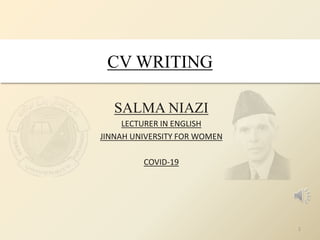Cv ppt online
- 1. CV WRITING SALMA NIAZI LECTURER IN ENGLISH JINNAH UNIVERSITY FOR WOMEN COVID-19 1
- 2. How to prepare a CV? 1. Donât start with a heading âCurriculum Vitaeâ â itâs obvious, redundant, and takes up needed space. 2. Begin with your name and surname instead. 3. If the readers may not be able to surmise your gender from your name, consider putting âMsâ or âMrâ in parentheses before your name.
- 3. Typical information âĒ Address and contact information (donât forget to include your e-mail address!) âĒ Education âĒ (Honours and Awards) âĒ Research âĒ (Teaching Experience) âĒ (Extracurricular Activities) âĒ Publications
- 4. How to prepare a CV? 1. Make sure to list your publications and major presentations, e.g. papers given at national conferences. 2. Use a standard format for references (already discussed). 3. If a paper has been accepted, but not yet published, list it as âin pressâ. 4. If it has been submitted, but not yet accepted, donât list it under Publications, but mention it in the Research section.
- 5. How to prepare a CV? 5. A scientific CV should not contain personal information, such as date of birth, marital status, health, or hobbies. 6. It is considered tacky to include a picture of yourself in your CV. 7. If there is nothing to list under given category, simply omit the category. 8. CVs are structured in reverse chronological order, i.e. within each category, items are listed from the most recent to the least recent.
- 6. How to prepare a CV? 9. Students: Include some contact information that is unlikely to change, not the address of your dorm or of a flat youâre currently renting. 10.Consider having different versions of your CV for different uses. 11.Remember to keep your CV up to date. 12.Proofread your CV very carefully, or better yet ask someone else to do so.






